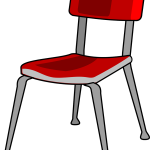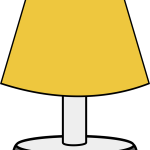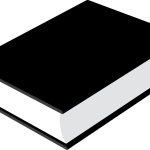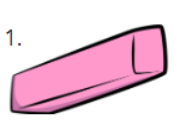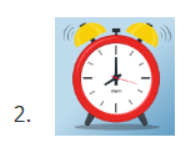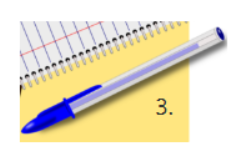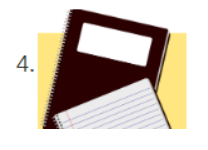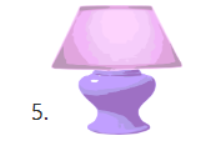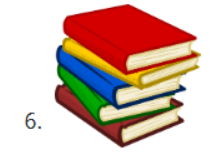6.2 der/die/das & ein/eine: bestimmte und unbestimmte Artikel
Gegenstände im Seminarraum / im Büro
Click on the hotspots in the illustration to learn the German terms for objects found in an office.
Image description
The following German terms are displayed as hotspots in the office illustration:
1. die Uhr (the clock)
2. der Ordner (the folder)
3, das Buch (the book)/die Bücher (the books)
4. die Lampe (the light)
5. das Fenster (the window)
6. der Stuhl (the chair)
7. der Tisch (the table)
8. der Boden (the floor)
9. das Bücherregal (the bookshelf)
Here are some additional German terms to remember:
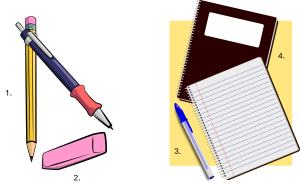
1. der Bleistift (the pencil)
2. der Radiergummi (the eraser)
3. der Kugelschreiber (the ballpoint pen)
4. das Heft (the booklet)
Nomen mit Artikel
Recap: German uses three definite articles in the nominative: bestimmte Artikel. They are “der” (masculine), “die” (feminine), or “das” (neuter) – all meaning “the” – to show the grammatical gender of a noun.
Nouns can also have indefinite articles: unbestimmte Artikel. They are “ein” (masculine), “eine” (feminine), and “ein” (neuter), all meaning “a” or “an” in English.
As in English, there is no indefinite article for the plural (just like in English, you couldn’t say “a books”).
To sum up: der (m.) –> ein die (f.) –> eine das (n.) –> ein die (pl.) –> ∅
See the following table for an overview with examples:
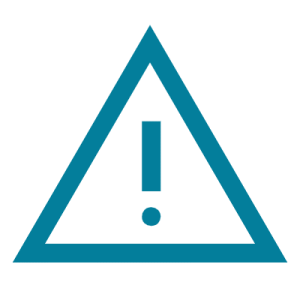 Achtung!
Achtung!
Das ist/Das sind (“this is/these are”) have nothing to do with the article “das.”
Übung 6.2a: Im Seminarraum
6.2a: 1. “School supplies (modified)“, by Rachel C, 2. “Alarm Time”, by dapple-designers, 3. & 4. “Notebooks (modified)”, by José Augusto Camargo, 5. “Lamp Purple”, by Clker-Free-Vector-Images, 6. “Books Literature”, by OpenClipart-Vectors, Pixabay Licence.
Click on the hotspots to learn German words for additional common items found in the classroom and home office. Listen to the audio provided below for the correct pronunciation.
Image Description
The following German terms are displayed as hotspots in the office illustration:
1. der Computer (the computer)
2. das Tablet (the tablet)
3, das Smartphone (the Smartphone)
4. der Laptop (the laptop)
5. die Tafel/das Whiteboard (the blackboard/whiteboard)
6. der Whiteboard-Marker (the whiteboard marker)
7. der Schwamm (the sponge)
8. die Wand (the wall)
Übung 6.2b
Drag the noun to the correct article (der, die or das). Review the vocabulary you just learned above before completing this activity.
Text Description
1. _____ Tafel
2. _____ Fenster
3. _____ Lampe
4. _____ Radiergummi
5. _____ Tablet
6. _____ Heft
7. _____Kugelschreiber
8. _____ Uhr
9. _____ Wand
10. _____ Stuhl
11. _____ Bleistift
12. _____ Smartphone
13. _____ Bücherregal
14. _____Tisch
Answers:
1. die
2. das
3. die
4. der
5. das
6. das
7. der
8. die
9. die
10. der
11. der
12. das
13. das
14. der
 Achtung!
Achtung!
In German, when stating someone’s nationality, place of residence or occupation no indefinite article is used.
Fatih Akin ist Deutscher. Fatih Akin is a German.
Maren ist Studentin. Maren is a student.
Ich bin Berliner. I am a Berliner.
Remember when J.F. Kennedy visited Berlin in 1963, he said: “Ich bin ein Berliner.” Had he learned German with us, he would have known not to use the indefinite article. Literally, he said “I’m a jelly donut”. However, the historical significance of his statement, though not entirely correct, was not lost on the people of Berlin.
Negation with “kein”
One way to express negation in German is with the negative form of the indefinite article “ein(e).” Here are some examples:
- Ist das ein Tisch? Nein, das ist kein Tisch.
- Ist das eine Lampe? Nein, das ist keine Lampe.
- Sind das Amerikaner? Nein, das sind keine Amerikaner, das sind Kanadier.
Here is how to form the negative article:
- masculine: ein –> kein
- feminine: eine –> keine
- neuter: ein –> kein
- plural: ∅ –> keine
Übung 6.2c
Fill in the negative article (kein, keine) and missing indefinite article (ein, eine) and noun depending on the picture. If no article is required just leave it blank and hit “enter”. Here are special characters to copy and paste if needed: ä ö ü ß.
Beispiel:
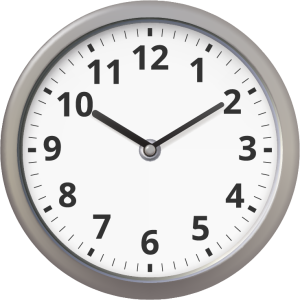
Text Description
1. Ist das ein Tisch? Nein, das ist __________ Tisch, das ist __________ __________.
2. Sind das Hefte? Nein, das sind __________ Hefte, das sind __________ __________.
3. Ist das ein Computer? Nein, das ist __________ Computer, das ist __________ __________.
4. Ist das eine Tafel? Nein, das ist __________ Tafel, das ist __________ __________.
5. Ist das ein Fenster? Nein, das ist __________ Fenster, das ist ___________ __________.
Answers:
1. kein/ein Stuhl
2. keine/Bücher
3. kein/ein Bleistift
4. keine/eine Lampe
5. kein/ein Smartphone
6.2c: 1. “Chair Blue“, 2. “Books Literature“, 3.”Pencil Sharp“, 4. “Lampshade“, by OpenClipart-Vectors, 5. “iPhone, Cellphone”, by Clker-Free-Vector-Images, Pixabay Licence.
“2.1” & “2.2” from Willkommen: Deutsch für alle by Claudia Kost and Crystal Sawatzky is licensed under a Creative Commons Attribution-NonCommercial-ShareAlike 4.0 International License, except where otherwise noted.

